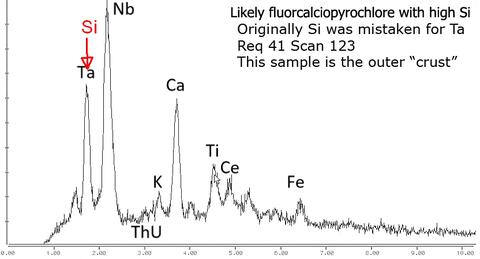This specimen features unusual variants of three minerals, fluorcalciopyrochlore, lorenzenite and birnessite, that are moderately uncommon at MSH even in their usual form. The pyrochlore and lorenzenite were analyzed via qualitative EDS. See the “Analysis” tab. The unusual features are the high content of Si in the pyrochlore; the fact that the lorenzenite is epitactic on aegerine, and, moreover, that it is from a pegmatite; and the fact that the birnessite is replacing rhodochrosite rather than sérandite.
The pyrochlore group at MSH presently consists of fluorcalciopyrochlore and fluornatrolpyrochlore. In the EDS scans for the fluorocalciopyrochlore, Ca is very evident, but Na not at all. However, the equipment used is very insensitive to Na and sometimes Na peaks get lost in the noise. Also, there might be other pyrochlore species at MSH, differing only in having OH, O, etc. instead of F – none of which can be detected via EDS. So the fluorcalciopyrochlore ID is a best guess – but that’s as good as it is going to get unless you are willing to pay for more sophisticated analyses.
What makes the pyrochlore on this specimen unusual (apart from the yellow color), is the presence of very elevated levels of Si. Apparently elevated levels of Si in pyrochlore are known from MSH (and elsewhere) but it is so unusual that the analyst was initially tricked into labeling the Si peaks as Ta. (The low energy Si and Ta peaks are very close – not readily distinguishable in an ordinary EDS scan. Higher energy Ta peaks could be used to distinguish it from Si, but these peaks can be obscured by charge build-up if the scan is performed with a sample on matrix – as was the case here.) Since one of the scans showed “Ta” > Nb, this led to speculation that the mineral might be “microlite”, but that is not the case. It is merely very weird “pyrochlore” – probably weird fluorcalciopyrochlore. (Explanations for how the pyrochlore could contain so much Si vary. This is not the place to go into that.)
In the most recent special issues on MSH (Lapis and Rivista, 2000), lorenzenite at MSH is not listed as occurring in pegmatites. But this lorenzenite is clearly from an altered pegmatite and was verified via EDS on samples from two different specimens.
Note: The scan #166 is a good fit for lorenzenite. Vinogradovite produces a similar scan, but the Si peak is higher relative to the Ti peak in that case. I have included scan #298X - from another specimen - for comparison.
Usually birnessite is found as jet black, partial to complete, pseudomorphs after sérandite. Much less common are birnessite pseudomorps after rhodochrosite such as the ones on this specimen. (As at the nearby Demix quarry, the birnessite is probably accompanied by ranciéite, but that’s not the sort of thing one can prove via quick & dirty EDS, so no attempt was made.)
The first pair of photos (FOV 2.45 x 3.35 mm) shows some of the bright yellow fluorcalciopyrochlore on aegirine. Note that the pyrochlore looks “fuzzy”, as if perhaps encrusted by some other mineral. But both the crust and the more typical (but still yellow) interior crystals produced similar EDS scans, with the interior having relatively more Si than the crust! The ”large”, slightly pinkish, crystals are albite. Some are quite well formed.
The second pair of photos (FOV 3.6 x 2.2 mm) shows lorenzenite needles, mostly (but not entirely) in parallel growth along the axis of the underlying aegirine crystal, suggesting an epitaxial relationship. The typical habit of lorenzenite varies from environment to environment, but this lorenzenite does not look like any of those. It was a surprise when EDS said “lorenzenite”. In fact it was so surprising that two scans were made, one on needles in parallel growth (like the ones in the photo, except that these emanated from the tip of an aegirie crystal rather than growing on the sides), and one on a random jumble of needles with no aegirine substrate.The scans were essentially identical. (I have only posted the one for needles growing in parallel.) Possibly this is a unique find.
The third pair of photos (FOV 2.45 x 2.85 mm) shows birnessite pseudorphs after rhodochrosite to ca 1 mm on edge. They sit on striated black aegirine. Both minerals are quite lustrous, making photography very difficult. Shiny black on shiny black is a tough subject - I was not able to entirely avoid blowouts from reflections. There are a few more, much less lustrous, birnessite pseudomorphs that might have been easier to photograph, but they are isolated and look rather “lonesome”. These are not complete pseudomorphs, the interiors of a few broken ones look “sickly” pinkish gray.
As mentioned, this is from an altered pegmatite. That means that there is a lot of “mineralogical dirt”. It may be possible to remove some of it, but probably not without also removing something of interest.
Single item shipping weight (no case) is 3.2 oz (90 g). For shipments outside the USA, up to a total weight < 8 oz (225g), this can be combined with items from this or other auctions for the same postage.
Within the USA, postage increases by about $0.20 per ounce. Above 13 oz, I will use Priority Mail ($9.25 including packing).

































